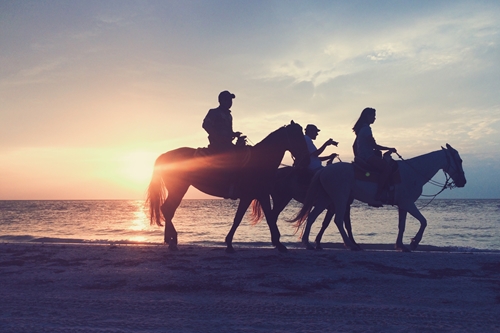Retired racehorses, otherwise known as off-track thoroughbreds, are a great choice for pleasure riding and other sports. Whether you plan to retrain your retired race horse for a new sport or are considering adopting one, here’s what you need to know to attend to its mental and nutritional needs.
“Let your horse get used to its new life before training.”
Caring for a retired racehorse’s mental health
Transitioning from racing to another sport is a drastic change. Your horse will travel less frequently, its schedule will be less regimented and it will likely spend more time interacting with other animals. In addition, barring any lameness or chronic illnesses, your horse’s nutritional needs won’t be as demanding. As your equine experiences the early days of retirement, it’s better to let it have a little rest and get used to its new life than to keep up its consistent training schedule, according to Equinews.
“Some people believe that because horses are fit from race training they need to keep them in training,” Kentucky Equine Research nutritionist Kathleen Crandell said to Equinews. “From a physiological standpoint, that might be true, but horses, like people, are not just physical beings. They also depend on mental soundness to perform well.”
Crandell went on to explain that a horse’s condition doesn’t change as easily as a person’s, and less exercise won’t lead to drastic weight changes. In fact, because racehorses have such a high metabolism, you’ll need to alter your OTTB’s diet to one focused on weight gain, not increased energy.
Properly feeding an OTTB
Understanding prior nutritional needs is important for creating a new diet, TheHorse.com noted. A newly retired racehorse’s condition will be either 4 or 5, and the animal will be used to consuming a surplus of vitamins, minerals, carbohydrates and fats. Grains, which are high in sugar and starch, make up half a racehorse’s diet. In addition, your animal will likely be used to consuming additional equine electrolytes. Finish Line’s Apple-A-Day supports electrolyte levels in animals used to working up a sweat during races.
“Switch to a forage-heavy diet to reduce the risk of ulcers.”
Continuing to feed your horse a high-carb diet when it doesn’t perform as intensely puts the animal at risk for gastric ulcers, especially if your equine eats a large amount during a single feeding. Switch to a forage-heavy diet and keep the quantity of grain your horse eats to a minimum to support proper digestion. You can also offer equine health care products like Finish Line’s U-7 Gastric Aid to promote healthy digestion.
Alter your horse’s diet to increase its condition – 5 is slightly too low for a low-performing or pleasure horse. Unfortunately, because racehorses are bred for incredible metabolisms, it can be difficult for them to put on weight. Give your OTTB as much access to pasture as possible. If your horse must be stabled for long periods of time, Equinews suggested feeding it a hay mixture of grass and legumes.
Adding more fat will also help your OTTB gain weight. Fat helps your equine’s attitude, combating the anxiety and quick tempers of most racehorses. If attitude is a major problem, try offering Quia-Cal to support healthy nerves.
If years of racing have taken a toll on your horse’s body, try Fluid Action HA to promote proper lubrication and strength or AirPower to support respiratory health. For a multisystem solution, Total Control Plus combines a number of Finish Line’s best-selling products – including Apple-A-Day, U-7 and Fluid Action HA – into a single horse health care product.
Once your horse has adjusted to its new lifestyle and receives the all-clear from your veterinarian, you can start training for its new career.








